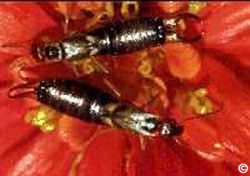The common name “earwigs” probably comes from the old superstition that the insects enter people’s ears and ultimately feed there. This superstition is totally folklore and has no merit whatsoever.
Are earwigs harmful to my garden?
 European earwigs should be considered beneficial as they feed on many plant pests, such as aphids, mites and insect eggs. Earwigs are nocturnal and roam to eat at night and are attracted to lights. They occasionally feed on flower blossoms and garden vegetables but this damage is usually minimal. To a large extent, the earwigs are a scavenger, feeding on decaying plant and animal matter.
European earwigs should be considered beneficial as they feed on many plant pests, such as aphids, mites and insect eggs. Earwigs are nocturnal and roam to eat at night and are attracted to lights. They occasionally feed on flower blossoms and garden vegetables but this damage is usually minimal. To a large extent, the earwigs are a scavenger, feeding on decaying plant and animal matter.
How can I identify an earwig?
This insect is readily identified by the pair of prominent forceps located at the rear of the body. Earwigs use these pincers for defense and for sparing rival earwigs. It is a ground insect although some can fly. The pincers are not used to aggressively attack people.
Where do earwigs hide in the home?
Earwigs can sometimes be considered a nuisance when they enter homes and are seen on household walls and ceilings. Interaction at this time results in a defensive free-fall to the ground, followed by a scramble to a nearby cleft or crevice. During the summer, they can be found near damp areas such as near sinks and in bathrooms. Invasions peak in late summer.
How can I control the earwig population near me home?
The most important part of controlling earwigs is eliminating their hiding places. If the earwig harborages are not addressed, insecticide application will probably not control earwigs very well. Consider changing outdoor light bulbs to yellow bulbs since white lights are more attractive to insects.
How can I stop earwigs from entering my home?
To deter earwigs from invading the home, clean up outdoor debris along foundation walls. Move landscape timbers, logs, firewood piles away from the foundation. Create a “dry zone” next to the foundation 6” to 12” wide so that earwigs will avoid it. Trim trees and shrubs that cause damp shady areas near the house Make a can trap with a shallow in can and fill with ½” vegetable oil. Also effective is to roll up old newspapers and place near the base of plants around sunset. Empty the captured earwigs into a bucket of water. Encourage natural predators like toads and birds in your yard. Spray earwigs with spray and wash cleaners which will kill the earwigs on contact. Use cockroach traps or spray, both are effective against earwigs.
For more information, see the following Colorado State University Extension fact sheet(s).
For more information, see the following Planttalk Colorado™ script(s).



